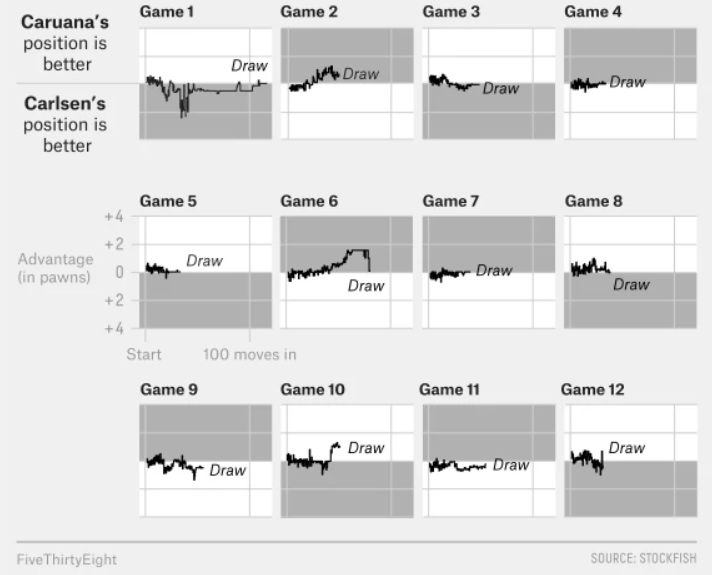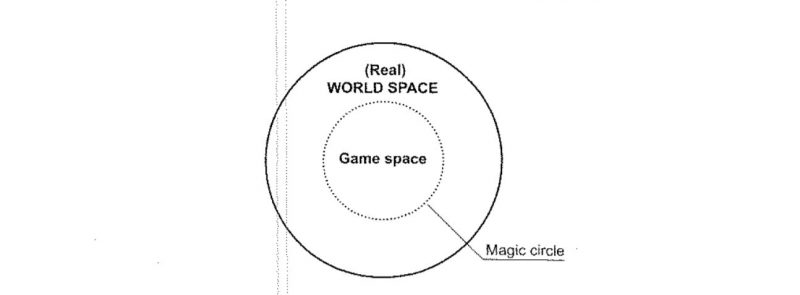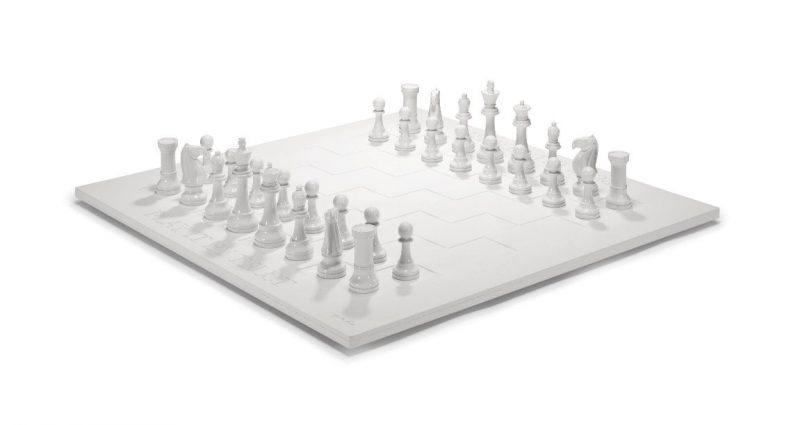Troubling Simulations; Wickedness
Posted on December 15, 2018Calming Chess
On November 9th, Magnus Carlsen of Norway and Fabiano Caruana, representing the United States, sat down in a soundproof booth at The College in Holborn in central London. A chess board sat on the table between them. These two, the highest-ranked chess players in the world, were competing for the title of World Champion as part of a tradition that goes back (officially) for decades, and unofficially, centuries.1
Some days later, as their best-of-twelve match dragged on over the course of a month, I absentmindedly clicked a stray link and found myself watching these men push their pieces about the board. For reasons that I couldn’t understand, I was completely enthralled. I’ve never had any interest in chess, but something about the slow, careful push-and-pull of the multi-hour matches was calming, so I continued to watch, at least passively, day after day.
As I watched the black and white pieces twist and turn across the tan-beige gamespace, I wondered about the nature of chess. It’s safe to say that a game of chess is complex, and it’s often described as “messy,” but I found myself asking if a game of chess was wicked in the way Rittel and Webber describe in their oft-cited paper on urban planning, in which they define “wicked problems”. Nominally, wicked problems are characterized as vague or unknowable, with no clear solution, no possibility of measuring success, and no possibility of testing. Where does chess land within this definition? As it turns out, the answer wasn’t hard to find. To quote Rittel and Webber:
“The problems that scientists and engineers have usually focused upon are mostly “tame” or “benign” ones. As an example, consider a problem of mathematics, such as solving an equation; or the task of an organic chemist in analyzing the structure of some unknown compound; or that of the chessplayer attempting to accomplish checkmate in five moves. For each the mission is clear. It is clear, in turn, whether or not the problems have been solved.”2

Roeder, Oliver. “Carlsen’s Bizarre Decision Has Sent The World Chess Championship To Overtime.” FiveThirtyEight, FiveThirtyEight, 26 Nov. 2018, fivethirtyeight.com/features/carlsens-bizarre-decision-has-sent-the-world-chess-championship-to-overtime/.
If a problem can be reduced and understood, it seems, it can be modeled, and therefore it is not wicked. To this point, Daniela Rosner, in discussing the cognitive science of Herbert Simon, describes one such form of this reduction. She describes the supposed process that humans take in reframing “ill-structured” problems by breaking them down into understandable, knowable chunks. Rosner defines this incremental problem solving, loosely, as solutionism.3 It would seem to stand that this method works well for problems which are decidedly not wicked. For example, twenty-two years ago, IBM’s Deep Blue defeated World Champ Garry Kasparov in a game of chess.4 Since then, chess players have relied heavily on computers for training and preparation. The analysis and guidance of supercomputers give human players an edge in understanding the task at hand by breaking it down and looking at each move discretely.5 It’s gotten to a point where a chess player, when they make a strong move, is said to have “found it,” in reference to the fact that a supercomputer monitoring the game, at any moment, has identified one move which is correct: the solution to the problem of the current arrangement of pieces on the board. Chess problems are not wicked; they can be broken down into solvable components which have objective solutions. Watching two Grandmasters play chess is like watching two supercomputers duking it out – albeit slowly. Perhaps it’s enthralling and calming because it’s occurring at the very edge of human, solutionist, resources. The problems are difficult, but comforting because they have solutions.
However, it leads me to wonder if there is a game that can be played beyond the solutionist edge. Are there games that exist beyond the boundary layer of human capabilities, in the zone in which the wicked problems that plague our world reside?
Wicked Games?
The concept of a wicked game may be dead on arrival, for many of the reasons detailed above. Jesper Juul posits that games are simulations of the real world or activity.6 I take this to mean, for example, that a game of chess is a simulation of war in a fictional world comprised of castles, knights, bishops, queens and kings. So, in this sense, any game, by definition, cannot be wicked because it exists, primarily, as a reduction. A game is nothing more than a well-structured problem pulled out of, perhaps, a wicked real-world problem; it is simplified from the start. However, I’m interested in the possibility of troubling this notion. Donna Haraway reminds us that we “live in disturbing times, mixed-up times, troubling and turbid times. The task is to become capable…of response.”7 As an answer to this call to “stay with the trouble” it is necessary to ask: If games are simulations – reduced, reducible and therefore purged of wickedness – is there an opportunity to reintroduce the trouble?
Cities: Skylines
It seems fitting to begin addressing the idea of reintroducing wickedness into these simulations by examining a game based on the very problems that preoccupied Rittel and Webber. Cities: Skylines is a city building simulator that promises to “realize the thrill and hardship of creating and maintaining a real city”.8 Needless to say, it falls short of accurately realizing the true nature of the problems that come with a “real” city. But, interestingly, its total lack of effort in presenting wickedness in a meaningful way serves as a ripe canvas for projections of wickedness. For example, Justin Roczniak creates videos which use narrative to project a fictional world onto the simulation, both as a satire, revealing the shortcomings of the game, but also as a troubling of the simulation.9

Rozcniak, Justin. “Cities: Skylines | Power, Politics, & Planning: Episode 2: Urban Freeways.” YouTube, 23 Jul. 2018, https://www.youtube.com/watch?v=rseaKBPkRPU.
In one example, Roczniak builds an urban highway through a residential neighborhood. Normally, in the Cities: Skylines simulation this is done seamlessly. You click on houses to delete them and drag the new road through the open space. Roczniak, however, before destroying the homes, shares (fictional) details about the people living in the buildings. He describes what their lives are like, and what compensation they receive from the eminent domain proceedings that force them out of their homes.10 It’s not the narratives themselves that add wickedness to the game; slapping a story on top of a ruleset does not create a wicked game. What the stories do, however, is break down the barrier between games and the real world by undressing the illusion. Juul states, building on the scholarship of Johan Huizinga, that games exist within a magic circle that exists apart from the real world. It seems that it is this separation that fundamentally prevents games from being with the trouble.

Juul, Jesper, Half-Real: Video Games Between Real Rules and Fictional Worlds, (Cambridge, Massachusetts, The MIT Press, 2005), pp 165.
Rozcniak, with his fictions, breaks down this barrier. By creating stories where, typically, there are none, he carves out a space for himself within the magic circle where the wickedness can enter. His overt politicization of the notably apolitical simulation is a testament to the effectiveness, and troubling nature, of this practice. If games are simulations, existing in a magic circle separate from the world, then the only way to make them wicked is to break down the circle to let the wickedness in.
Wicked Chess

Ono, Yoko, Play It By Trust, 1997, sculpture.
Chess, like the modern city builder, has also served as a canvas for troubling explorations and investigations into war and conflict. Yoko Ono’s Play It By Trust breaks down a number of barriers. By painting a chess set all white, the color of surrender, and by inviting interaction and engagement, Ono is encouraging people to step into the “magic circle”. By reframing the familiar game, she is carving out a space within that circle for participants to questions the nature of conflict, trust, and the quotidian. She is creating space for wickedness to enter. Similar efforts, like Ruth Catlow’s Rethinking Wargames: A Chance to Remaster Conflict, opens up similar spaces by reformatting chess. In doing so, Catlow is commenting on global conflicts, specifically the U.S. bombing campaign in Afghanistan post-9/11.11
The use of subversion, reframing, and recontextualizing, along with the use of fiction and narrative, can take complicated games and create wicked spaces within them. Such tactics are necessary if we are to understand, simulate, and play with the complexities of our time.
-ryan
- “History of the World Chess Championship.” com, www.chessgames.com/wcc.html.
- Rittel, Horst W. J., and Melvin M Webber. “Dilemmas in a General Theory of Planning.” Policy Sciences, no. 4, 1973, pp. 160.
- Rosner, Daniela K., Critical Fabulations; Reworking the Methods and Margins of Design, (Cambridge, Massachusetts, The MIT Press, 2018), pp. 29.
- Anthony, Sebastian. “A New (Computer) Chess Champion Is Crowned, and the Continued Demise of Human Grandmasters.” ExtremeTech, 31 Dec. 2014, extremetech.com/extreme/196554-a-new-computer-chess-champion-is-crowned-and-the-continued-demise-of-human-grandmasters.
- Roeder, Oliver. “Computers Are Haunting The World Chess Championship (Which, Yes, Is Still Tied).” FiveThirtyEight, 13 Nov. 2018, https://fivethirtyeight.com/features/computers-are-haunting-the-world-chess-championship-which-yes-is-still-tied/.
- Juul, Jesper, Half-Real: Video Games Between Real Rules and Fictional Worlds, (Cambridge, Massachusetts, The MIT Press, 2005), pp 170.
- Haraway, Donna, Staying with the Trouble: Making Kin in the Cthulucene, (London, Duke University Press, 2016), pp. 1.
- “Cities: Skylines.” Paradox Plaza, https://www.paradoxplaza.com/cities-skylines/CSCS00GSK-MASTER.html.
- Kunzelman, Cameron. “The Socialist YouTuber Using Cities: Skylines To Explain Politics.” Kotaku, 22 Sept. 2018, https://kotaku.com/the-socialist-youtuber-using-cities-skylines-to-explai-1829245653
- Rozcniak, Justin. “Cities: Skylines | Power, Politics, & Planning: Episode 2: Urban Freeways.” YouTube, 23 Jul. 2018, https://www.youtube.com/watch?v=rseaKBPkRPU.
- Flanagan, Mary. Critical Play: Radical Game Design. (Boston, MIT Press, 2013), pp. 112-115.